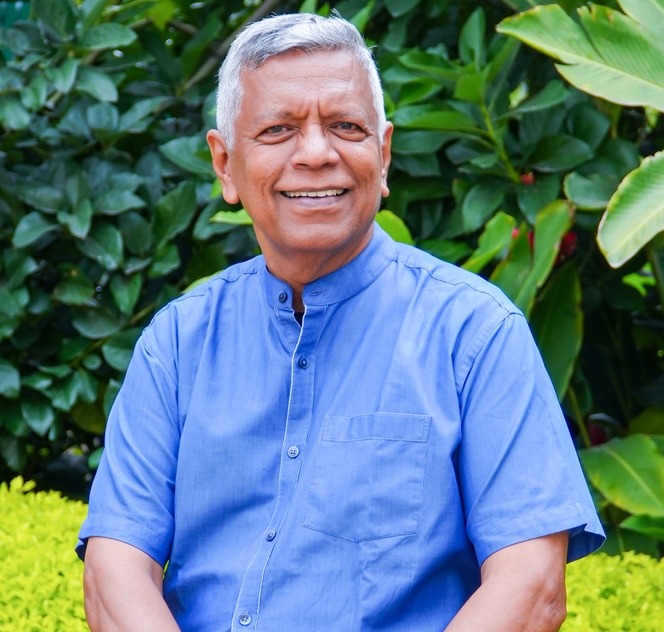At 65, most people are thinking about retirement. Dr. Venkatraman Chandra-Mouli (Chandra, as he is widely known) was earning his PhD. While many of his classmates from medical school are winding down their careers, he was just getting started on what he calls his “most important work yet.”
After three decades at the World Health Organization, this soft-spoken Indian doctor has become one of the world’s most powerful voices for young people’s sexual and reproductive health. His message is simple but revolutionary: stop doing what doesn’t work, and start doing what does, now!.
A Problem That Many Don’t Want to See
There has been progress in the areas of adolescent sexual and reproductive health that the world has invested in, substantially and over time. One example is that the birthrate in girls aged *15-19 has halved over the past 30 years from 73 to 38 births per 1000 girls. Still 12 million girls of that age are expected to give birth this year. And although births in girls aged 10-14 have declined even more sharply, from 4 – 1 over the past three decade, more than 325,00 girls aged 10-14 are expected to give birth this year. The vast majority of these births are from the poorest families and communities in low- and middle-income countries. Most of the girls didn’t want to get pregnant and become mothers so early. Many will never return to school. Some will die from complications that could have been prevented.
The progress—although slow and uneven—in reducing adolescent fertility, child marriage, and HIV infection/HIV-related deaths contrasts with the virtually no progress in other areas over the last three decades. For example, nearly one in five adolescent girls aged 15-19 have experienced intimate partner violence in the past year. In the lowest income countries, the proportion rises to one in four girls.
These aren’t just numbers to Dr. Chandra-Mouli. They represent a crisis that many community leaders and members, national governments, and global institutions are unable or unwilling to see and do something about.
His frustration is palpable when he talks about the enormous amount of money and effort wasted on programs that sound good but don’t work. Youth centers that sit empty. Peer education programs that change little. One-off public meetings about child marriage that leave everything exactly as it was.
The Revolutionary Who Questions Everything
What makes Dr. Chandra-Mouli different isn’t just his credentials—though working on adolescent health in WHO for 27 years and leading the work in this area for 18 years certainly helps. It’s his willingness to say what others won’t: that much of what we call “best practice” in adolescent health is actually far from best practice.
In 2015, he co-authored a groundbreaking commentary in Global Health: Science and Practice that became one of the journal’s most downloaded articles. The paper systematically destroyed the reputation of popular but ineffective interventions.
“Ineffective interventions should be abandoned, while proven strategies like comprehensive sexuality education and youth-friendly services need to be implemented with fidelity.”
The reaction was explosive. Conference rooms fell silent. Funders who had invested millions in the criticized approaches pushed back hard. But the evidence was overwhelming, and Dr. Chandra-Mouli didn’t back down.
Beyond the Ivory Tower
What sets this doctor apart is that he doesn’t just criticize—he builds. After retiring from WHO in 2023, he could have disappeared into comfortable academic obscurity. Instead, he’s working harder than ever, collaborating with organizations around the world to implement solutions that actually work.
One example is an analysis of a highly resourced, multi-year, multi-country adolescent sexual and reproductive health project, in which he and his coauthors listed its missteps and shortcomings identified by independent evaluations and then pulled out issues of relevance for the wider community with a clear set of ‘dos’ and ‘do nots.’
At the risk of ruffling feathers, they called for all stakeholders to “take steps to rebalance their programs and investments to not only seek new solutions (i.e., game changers) but to also invest in the institutionalization of the solutions that have been generated over the past 40 years, prioritizing those that have shown evidence of effectiveness (i.e., adolescent-responsive health service delivery) and those that demonstrate significant promise (i.e., social norm change).”
Another example is a paper that emanated from his PhD research on school-based sexuality education, which reveals how six “positive deviant” low-and-middle-income countries successfully scaled up comprehensive programs using opportunities that came their way and overcoming the constraints and resistance that they did. The secret? They moved forward doggedly, one day at a time, and didn’t give up when things got difficult.
“Countries that have successfully scaled up, sustained, and enhanced their Sexuality Education programs have done so by carefully planning, securing resources, and continuously overcoming resistance.”
The Personal Behind the Professional
Dr. Chandra-Mouli’s passion for this work runs deeper than professional commitment. His personal story reveals a man who understands struggle intimately: teenage romance, early widowhood, remarriage, and learning to parent a child with disabilities. Read his personal story here.
“Every day is a gift I grab with both hands.”
This perspective infuses his work with unusual humanity. When he talks about adolescent health, he’s not discussing abstract policy frameworks. He’s talking about real young people facing impossible choices with inadequate support.
Fighting for the Future
Dr. Chandra-Mouli’s passion for this work runs deeper than professional commitment. This is evident in his latest co-authored commentary in the Journal of Adolescent Health entitled “Shock Unleashed by Recent U.S. Administrative Actions Cannot Lead to Paralysis.”
“Those of us dedicated to adolescent health and well-being are shocked and saddened, but we cannot afford to be paralyzed. We must get up, regroup, and move ahead. We must work on three fronts to navigate these difficult times: we must safeguard and build on the learning and the progress made in many low and middle income countries; we must proactively and effectively counteract the attacks on ASRH and on SRHR more widely; and we must join forces with like-minded colleagues everywhere who are committed to not only adolescent health but to advancing social justice and autonomy in LMIC.”
True to character, he refuses to retreat. He doesn’t just document the crisis. He maps a path forward.
A Legacy in Motion
At an age when most doctors are preparing to ‘hang up their boots’, Dr. Chandra-Mouli is building his most important legacy. He’s inspiring and building a new generation of advocates who refuse to accept ineffective solutions. He’s supporting networks of practitioners committed to evidence-based approaches. He’s creating momentum for change that could reach millions of young people. And to ensure that there is not even a shred of conflict of interest, he is working independently, without any organizational affiliation, and without any remuneration in cash or in kind.
His three recent awards – including the USA’s Society for Adolescent Medicine and Health’s Lifetime Achievement Award, the Rotary International Award for outstanding leadership, scholarship and service in adolescent sexual and reproductive health, and the World Association of Sexual Health Gold Medal for his lifetime’s work on sexual health and rights – recognized not just past contributions but ongoing impact. You can read more about his 2024 activities here.
The Fight Continues
Dr. Chandra-Mouli’s story is far from over. As he continues to learn, to communicate, to teach, to advise and to support adolescent health work. His core points to what is both urgent and important, we know what works for young people’s health, but we’re just not doing it.
In a book chapter he published last year in “Teenage pregnancy and young parenthood: effective policy practice, second edition” which documented successful national government led initiatives in reducing adolescent pregnancy in Africa, Asia, Europe and Latin America, he noted:
“The experiences of these countries – in different social, cultural, and economic contexts shows what can be achieved with the application of good science combined with bold leadership and strong management. They challenge and inspire us to do what is doable, and urgently needs to be done.”
The doctor who won’t give up continues fighting for a simple idea: that every young person deserves access to the information and services they need to make healthy choices about their bodies and their futures. In a world that often fails its young people, that’s a revolution worth supporting.

